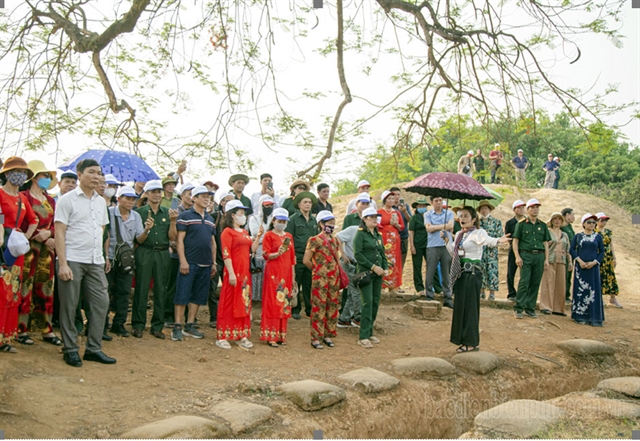 Life & Style
Life & Style

Nguyễn Thanh Hà
Điện Biên’s culinary culture has played an important role in luring visitors and travellers to the province, bringing stable income for locals.
Nguyễn Minh Phú, director of Điện Biên Department of Culture, Sports and Tourism, says the region is known far and wide for its special dishes such as kitchen-smoked buffalo meat, grilled fish (pa pỉnh tộp), multi-colour sticky rice, bamboo worms and more. Other specialities include Mông wine, mountain goat, Đà River fish, black chicken and chẩm chéo dipping sauce.
It has many cultural villages and hamlets that lure visitors.
"For example, Phiêng Lơi Hamlet, lying at the entrance to Điện Biên Phủ City, has a beautiful landscape, ethnic culture and excellent dishes. It has strongly developed its tourism scene, which brings stable monthly income for locals and preserves its traditional cultural identity," Phú says.
“Điện Biên has placed importance on developing its culinary scene. We recognise this is important for tourism.”
As a result, Điện Biên now has many ethnic food restaurants and mountainous markets. They all supply local ingredients to cook traditional dishes for visitors.
Điện Biên is promoting its One Commune, One Product (OCOP -- One commune has one speciality product) items such as Hương Linh – Tủa Chùa Tea, and Mường Ảng Coffee to tourists. Furthermore, the province has also issued documents and books on the culinary culture of ethnic groups as an intangible heritage and reference for guests before their tours.
To make Điện Biên more famed for its food, it plans to promote its culinary culture inside and outside the province.
“We will organise competitions on how to cook quality dishes, vote culinary trademarks and plan a special food street or zone to lure more and more visitors,” says Phú.
Are you a lover of food and travel? If so, you can use your holiday to discover the traditional mountainous specialities of Điện Biên in the heart of the Northwestern region. There are a number of unique dishes you can try:
Grilled fish (pa pỉnh tộp)
To make this dish, cooks from the Thái Đen ethnic group first choose a large fish weighing 1-1.5 kg. The fish is cleaned before a mix of mắc khén (forest pepper), fresh minced chilli, green onions, herbs, and coriander is stuffed into its belly. It is then cooked on a bamboo stick over charcoal. When the fish is well done, it turns a golden colour, and leaves a mouthwatering fragrance.
 |
| Pa pỉnh tộp is very tasty grilled fresh fish of Điện Biên Province. Photo ticotravel.com.vn |
"The fish is tough with a strong flavour that is savoury and hot from the chilli and mắc khén, and fragrant from the herbs, says a tourist. “It is so tasty that no other fish can compare to it,” he says.
Steamed black chicken
Tourist Lưu Bình from Hà Nội says that when visiting Tủa Chùa Village, eaters should enjoy special steamed black chicken served by local cooks.
The Tủa Chùa black chicken, known locally as ka đu, has black skin and bones, but its feathers have various colours, such as black, white, grey, and yellow. The animal has adapted to survive in wild conditions. The chicken sleeps in trees and eats local maize and rice, so its meat is more savoury, fragrant and firm than normal chicken.
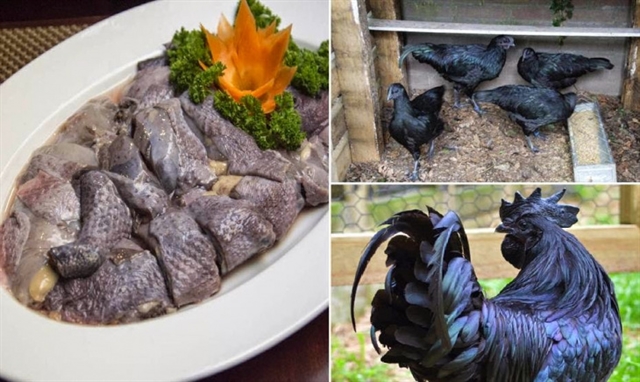 |
| Tủa Chùa's special black chicken is not only tasty but also widely used as a medicine for weak patients and pregnant women. Photo mytour.vn |
“The black chicken is so healthy that people consider it a precious medicine. They cook it in attractive dishes such as steamed black chicken, roasted chicken with hạt dổi (special spice seeds collected from the forest), chicken in hotpot, and porridge for pregnant women and children," says Giàng A Páo, a local resident.
The chicken is soaked with local spices and special herbs for 20 minutes, tied with lemongrass leaves and steamed over charcoal for half an hour. It is very savoury, and made more delicious with the delicate aromatics.
Multi-colour sticky hill rice
The sticky rice has been widely planted in Northwestern provinces, but local Trịnh Thị Hải says the tastiest is Điện Biên sticky rice. The plump rice grains are fragrant and soft when steamed.
The Thái ethnic group often enjoys the sticky rice with fish and pork grill, says Hải, adding that visitors to the province often buy the rice to take on their tours.
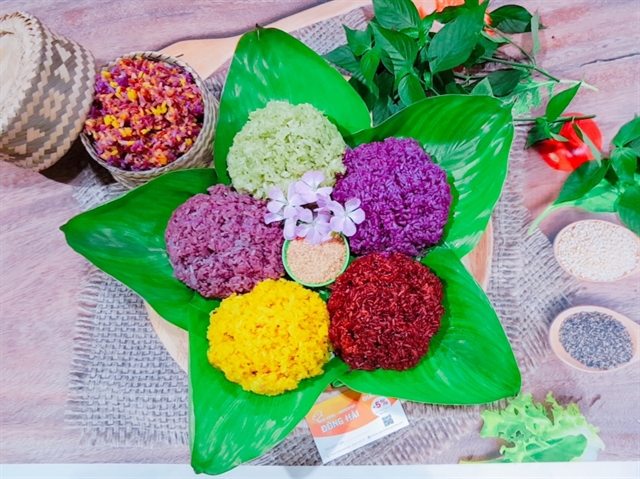 |
| Điện Biên's multi-colour sticky rice is well known far and wide. Photo ticotravel.com.vn |
“In the light cold of the Northwestern mountains, guests found it difficult to forget its soft and aromatic flavour. It is more enjoyable when balling the sticky rice by hand,” says Hải.
Ban flowers
Visiting Điện Biên, particularly in March and April, visitors can immerse themselves in an atmosphere of festivities and enjoy white ban (Bauhinia) flowers everywhere, especially the delicious dishes made from the flowers.
Local elder Bùi Thị Điệt likes to relate a folk story about the ban
"A beautiful young girl named Ban fell in love with a poor but handsome man near her village. But her parents didn’t agree to their union, forcing her to marry an old rich man instead," says Điệt.
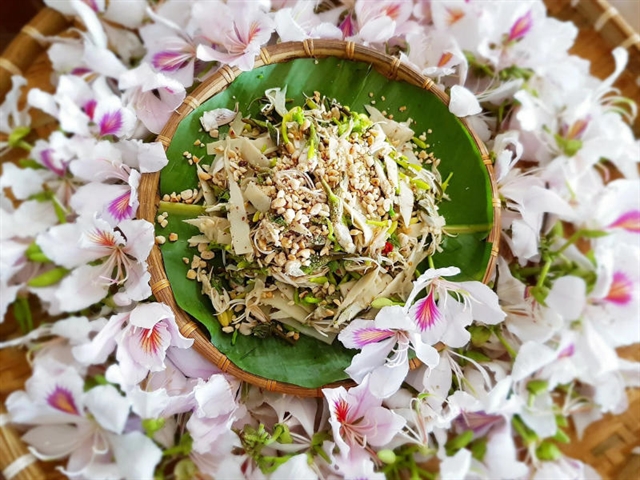 |
| Ban flower salad is a genuine dish attracting a lot of foodies. Photo ticotravel.com.vn |
"Ban disagreed with her parents, and fled her home to seek her true love. But she died of exhaustion on the way to find her man. At the very spot where she died, a tree with white flowers which bloom in spring soon grew. Locals have taken the name of Ban for flower ever since."
Hoàng Thị Nọong, 60, a Thai ethnic woman, who is a manager of homestay Mường Trời in Điện Biên, says there are many dishes made from ban flowers, such as xôi ban (sticky rice with ban flower), ban salad, fried ban flowers with bamboo shoots and ban soup.
Nọong says most guests at her restaurant like food cooked with ban flowers, but many are interested in ban salad, which is a mix of chilli, peppers, dổi (talauma), mắc khén, and wild seeds the Thais use to give extra spice.
“The salad is rich in aroma and is delicious. I enjoy it so much,” says writer Nguyễn Hoàng Hưng, who returns to the region once a year.
Bon soup
The soup is a traditional dish of the Thái ethnic group. It is cooked with ingredients such as buffalo or cow skin, water taro, wild tomatoes, herbs and spices.
Through the skilled hands of Thai cooks, the dish is known for its buffalo or cow skin mixed with slightly bitter flavour of wild tomatoes, as well as the spice mắc khén and aroma of lemongrass leaves.
Kitchen-smoked buffalo meat
Smoked meat is a favourite speciality of Điện Biên ethnic groups, whether buffalo, pork or beef.
The main factor in ensuring tasty kitchen-smoked buffalo meat is that the meat comes from free range buffaloes on hilly land. Their meat is firm and creates a fragrant smoked meat, according to local Hào Giàng Xén.
The meat is soaked with mắc khén, salt, lemongrass leaves, chilli, sugar and garlic for two hours before using bamboo skewers to hang them over the kitchen on wood fire for about 15 hours.
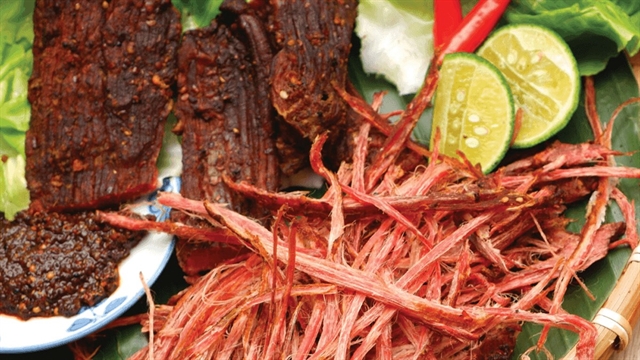 |
| Youngsters and wine drinkers are interested in kitchen-smoked buffalo meat so much. Photo ticotravel.com.vn |
When perfectly done, it has a brown-red colour with an aromatic flavour carrying the characteristics of the region’s mountains and forests.
Duck braised
Duck braised with banana flowers is also among the top Điện Biên specialities loved by visitors, Xén says.
The duck is cleaned carefully and soaked with mixed minced chilli, lemongrass leaves, ginger, mắc khén, and banana flowers for half an hour, then wrapped in banana leaves and cooked for three hours under a small fire. The dish is savoury from the duck and extra delicious due to the spice mix.
Green oleaster wrapped in cabbage
This is a lovely dish of the Thái, which often grabs the interest of visitors to the region.
Xén says the oleaster fruit should be young and green. It is then wrapped in fresh cabbage and dipped in chẳm chéo, a special sauce made by the locals.
“You might be confused after the first bite, but later the acridity of cabbage, slightly sour flavour from oleaster, and spice from the ginger, chilli, salt and fragrant chẳm chéo sauce, will leave you wanting more,” Xén says.
Chẩm chéo dipping sauce
This is an indispensable sauce in the daily meals of the Thái ethnics in Điện Biên.
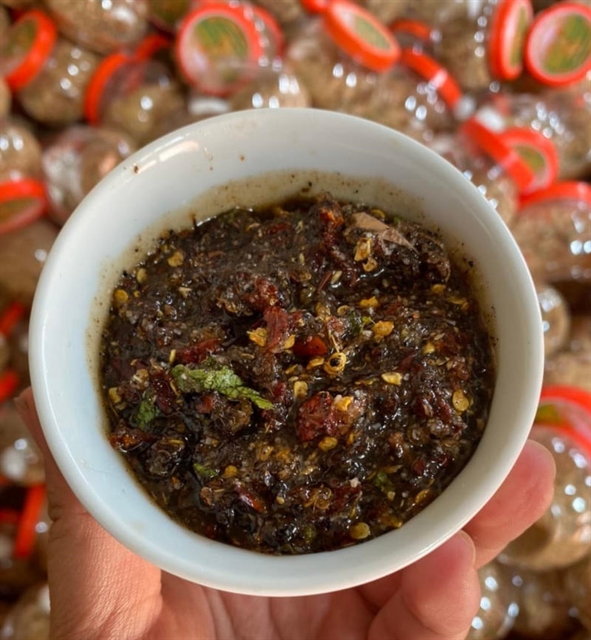 |
| Chẳm chéo, a special dipping sauce made by Thái cooks, receives a lot of praise by visitors. Photo mia.vn |
Lê Thị Duyên, who runs Điện Biên Gift Cooperative, says the main ingredient of the sauce is mắc khén mixed with salt, grilled fresh chilli, dried chilli, garlic and broth mix.
“All are ground together to become a viscous sauce. It is called chẳm chéo in the Thái language,” says Duyên. VNS




